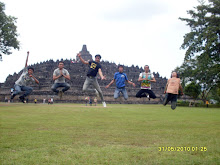Teaching speaking using Audiolingual method
Drills and pattern practice are typical of the Audiolingual method. (Richards, J.C. et-al. 1986) These include
Repetition : where the student repeats an utterance as soon as he hears it
Inflection : Where one word in a sentence appears in another form when repeated
Replacement : Where one word is replaced by another
Restatement : The student re-phrases an utterance
Examples:
Inflection : Teacher : I ate the sandwich. Student : I ate the sandwiches.
Replacement : Teacher : He bought the car for half-price. Student : He bought it for half-price.
Restatement : Teacher : Tell me not to shave so often. Student : Don’t shave so often!
The following example illustrates how more than one sort of drill can be incorporated into one practice session :
“Teacher: There’s a cup on the table … repeat
Students: There’s a cup on the table
Teacher: Spoon
Students: There’s a spoon on the table
Teacher: Book
Students: There’s a book on the table
Teacher: On the chair
Students: There’s a book on the chair
etc.”
There are more example that applying the audio lingual method in the class room. The students would perform the dialogue. Their voices would be recorded by the teacher.
1. First activity
a. Planning
1) Making lesson plan based on the teaching-learning activity
2) Preparing the test instrument (a series of dialogues consists of four different dialogues)
3) Preparing teaching facilities (board marker, eraser, and tape recorder)
4) Preparing hand-rolled paper and assessments sheets.
5) Preparing students’ attendance list
b. Acting
1) Teacher introduced herself to students.
2) Teacher called the students’ name.
3) Teacher explained her aim in conducting an action research in the classroom.
4) Teacher introduced the dialogues.
5) Students read the dialogues
6) Teacher asked students to work in pairs, read the dialogues and performed the dialogues.
7) Teacher recorded the test, analyzed the result of the test and gave scores to the students.
2. Second Activity
In second activity, the writer would present Audio-lingual teaching as the method in teaching speaking. In order to make the teaching learning process effective, it was necessary for each member of the class to participate. The following procedures are:
a. Planning
1) Choosing the teaching material: introducing
2) Arranging a lesson plan based on the teaching material.
3) Preparing the test instrument
(1) hand-out consists of a series of dialogues.
(2)Pictures that was appropriate to the teaching material
4) Preparing teaching facilities (board marker, eraser and tape recorder)
5) Preparing observation sheets
6) Preparing students’ attendance list
b. Acting
1) Teacher showed some pictures to the students
2) Teacher distributed the copies of dialogues to each students
3) Teacher read the dialogue
4) Students listened and repeated the teacher
5) Teacher drilled the students
6) Teacher divided the class into group of four (each group consists of four persons).
7) Students practiced the dialogue until they memorized the dialogues
8) Students performed the dialogue in front of the class
3. The last activity
In the last activity, the students performed the dialogue that given in the two previous meeting. The teacher recorded he students’ voices. The following procedures are:
a. Planning
1) Making lesson plan based on the teaching learning activity
2) Preparing the test instrument (a series of dialogues)
3) Preparing teaching facilities (board marker, eraser, and tape recorder)
4) Preparing hand-rolled paper and assessment sheets
5) Preparing students’ attendance list
b. Acting
1) Teacher distributed the handout to students
2) Teacher introduced the dialogues
3) Students read the dialogues
4) Teacher called students’ name
5) Students performed the dialogue
6) Teacher recorded the test and noted the score for each category
Scoring Technique
In this study, only gave scores on fluency quality of communication, pronunciation, and effort to communicate. The students would be called out in turn and giving dialogues relating to the material. In giving scores, based to Walter Bartz (Bartz cited in Valette, 1983:150) there are four items that was important to be scored: fluency, quality of communication, amount of communication, and effort to communicate.
Subscribe to:
Post Comments (Atom)

No comments:
Post a Comment